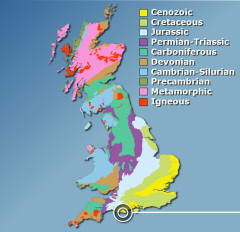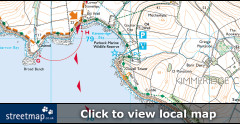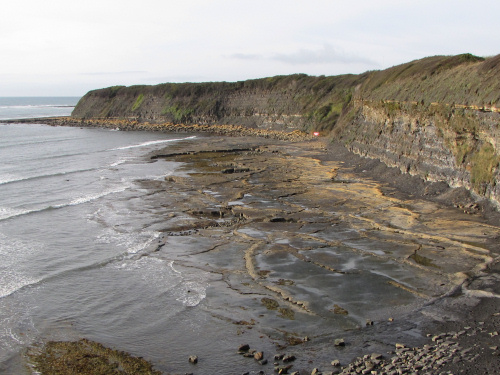
Established 2002
Lucinda Shepherd, friend Robert Randell and various experts for their support.
Kimmeridge (Dorset)

Click above to view page as a PDF.
Click here to download PDF software.
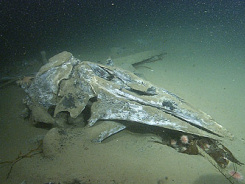
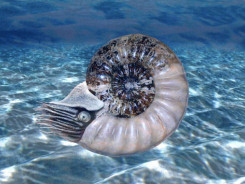
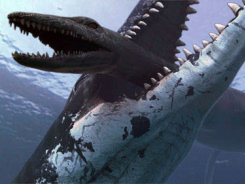
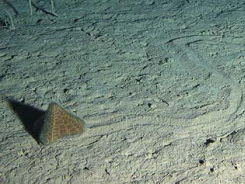
Introduction
Kimmeridge is a small coastal village in Dorset, located 13 miles east of Weymouth, and has a resident population of approximately 110 people. Despite its modest size the village commands international recognition for the interval of geological time known as the Kimmeridgian Stage which takes its name from the Kimmeridge Clay that was first described in the area.
The Kimmeridge Clay (Formation) is composed of fossil-rich mudstones and oil shales which originally accumulated as soft sediment at the bottom of the sea approximately 156-148 million years ago. This interval of 8 million years spans both the Kimmeridgian Stage and part of the subsequent Tithonian Stage of the Late Jurassic Epoch. Today much of the Kimmeridge Clay is elevated above sea level and outcrops locally in the cliff-face and on the foreshore between Brandy Bay in the west and Chapman's Pool towards the southeast.
Fossils occur commonly throughout the Kimmeridge Clay, in particular the shells of ammonites and bivalves. Less common finds include the skeletal remains of marine reptiles and in extremely rare instances the bones of dinosaurs and pterosaurs.
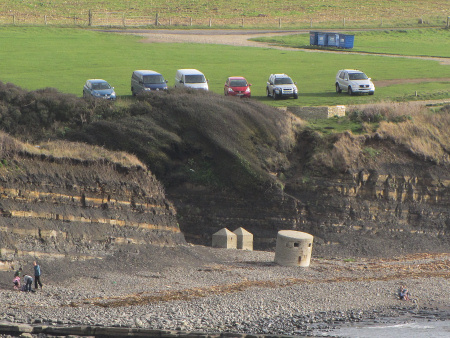
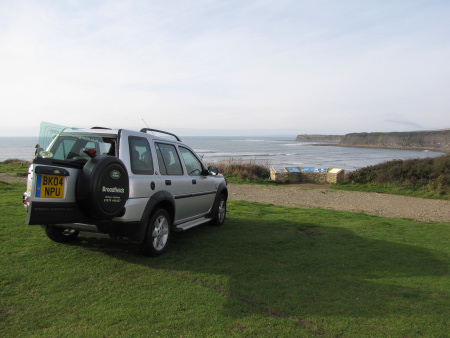
Left: Cliff-top
parking is available at Kimmeridge Bay.
Right: The view from the car park looking
southwest across Kimmeridge Bay towards Hobarrow Bay.
Access to Kimmeridge Bay is made along a narrow road which passes through the village and continues through Smedmore Estate (see map above). A toll to drive along the road is payable at a roadside kiosk a short distance from the village. Plenty of parking is available at the cliff-top, alternatively a small number of spaces can usually be found at the southeast end of the bay alongside the boat yard.
Although fossil hunting is permitted at Kimmeridge Bay, the use of hammers is not. These restrictions apply to Kimmeridge Bay specifically and normal fossil hunting can be undertaken outside the bay in either direction. See 'Where to look for fossils?' further down the page for more information.
The geology of the Kimmeridge area
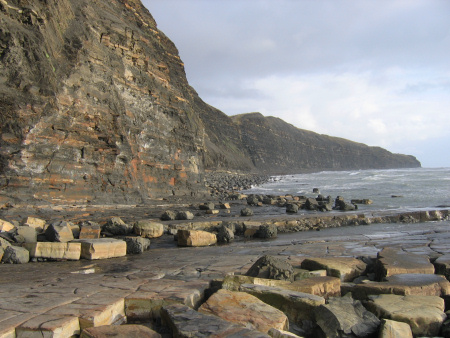
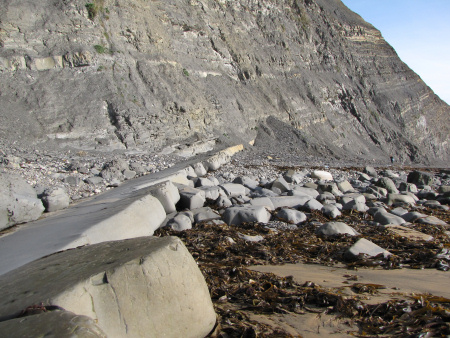
Left: The Upper
Kimmeridge Clay Formation exposed in the cliffs southeast of
Kimmeridge Bay, towards Chapman's Pool (3 miles from Kimmeridge
Bay).
Right: A conspicuous muddy dolomitic limestone within the Upper Kimmeridge Clay Formation
at
Brandy Bay, known locally as the Cattle Ledge Stone Band.
The rocks exposed in the cliffs and on the foreshore at Kimmeridge Bay and towards Brandy Bay in the west and Chapman's Pool in the southeast belong to the Kimmeridge Clay Formation. The formation was first described in the area in 1816 and takes its name from the neighbouring village/bay.
The formation comprises rhythmic alternations (in places) of soft mudstones, calcareous mudstones and kerogen-rich mudstones/shales, the latter of which can yield oil and gas when heated. Layers of muddy dolomitic limestone (as shown above-right) occur at a number of levels and form prominent ledges on the beach. The formation is over 500 metres thick locally, much of which occurs below beach level.
The mudstones were deposited at the bottom of a warm relatively shallow sea that extended across much of Great Britain and Europe during the Late Jurassic Epoch. In the Kimmeridge area the water depth was likely between 50-100 metres and the nearest significant landmass occurred c.40 miles to the south and west. At this time the Kimmeridge area was located closer to the equator, approximately 35°N, on an equivalent latitude to the Mediterranean Sea today.
Despite the presence of fossilised benthic fauna (seafloor dwelling organisms) the seabed is understood to have been anoxic (stagnant) for much of the time, with opportunist organisms (in particular bivalves) colonising the area during brief periods of more oxygenated conditions. Among the theories raised to explain these oxygenation events were violent storms. The abundance of fossil ammonites and other organisms that spent their lives higher in the water column reflects individuals that died and sank to the seabed, where the low oxygen levels and corresponding reduced activity of scavengers and bacteria favoured the preservation of their remains.
The Kimmeridge Clay Formation is divided into Lower and Upper parts, which can be distinguished by the ammonite fauna in particular. The Lower Kimmeridge Clay is characterised by species of Pictonia, Rasenia and Aulacostephanus; whilst Pectinatites and Pavlovia are present only in the Upper Kimmeridge Clay.
The Lower Kimmeridge Clay Formation corresponds with the Kimmeridgian Stage of the Late Jurassic Epoch, an interval of approximately 5 million years between 156 - 151 million years ago (mya). The Upper Kimmeridge Clay Formation corresponds to the early part of the Tithonian Stage of the Late Jurassic Epoch, an interval of approximately 3 million years between 151 - 148 mya. In total the Kimmeridge Clay Formation spans approximately 8 million years between 156 - 148 mya. See geologic timescale for context.
In the Kimmeridge area geologic forces have uplifted the rock, exposing the complete sequence of Upper Kimmeridge Clay and the uppermost beds of Lower Kimmeridge Clay (the lower beds remain locally buried below the surface). See figures 1 and 2 below for a summary of the key geological horizons.

Figure 1: A summary of
the geological units in the cliffs and on the foreshore
at Brandy Bay and Hobarrow Bay, west of Kimmeridge Bay.

Figure 2: A summary of
the geological units southeast of
Kimmeridge Bay beneath Cavell Tower, Hen Cliff and towards Chapman's
Pool.
At Kimmeridge Bay the underlying oil bearing rocks have been commercially drilled using modern techniques since 1959, extracting up to 80 barrels of oil daily. The oil reservoir (more akin to a giant sponge-like rock than an underground lake) occurs locally 500m beneath the surface. The British Petroleum oil well can be viewed up close alongside the footpath above Kimmeridge Bay (shown below).
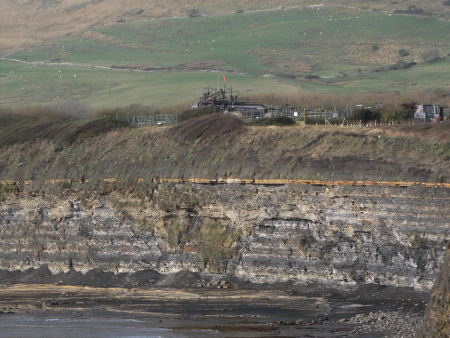
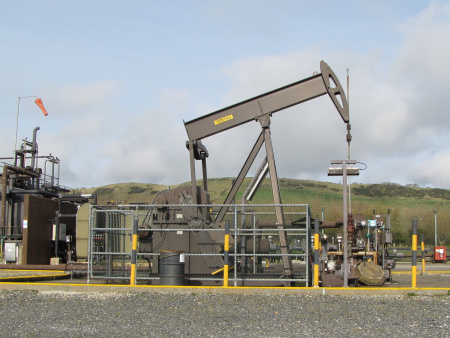
Left: The cliff-face
at Kimmeridge Bay with BP's oil well visible at the cliff-top.
Right: The oil well
produces up to 80 barrels per day.


ADVERTISEMENT BY UKGE - OFFICIAL ADVERTISING PARTNER OF DISCOVERING FOSSILS
Where to look for fossils?
Fossils can be found at any point between Brandy Bay and Chapman's Pool, including Kimmeridge Bay itself, although the latter tends to be over collected due to the volume of tourists attracted to the beach. As the use of hammers is not permitted at Kimmeridge Bay, fossil hunting is confined to searching for fossil material visible on the surface of beach pebbles, in particular ammonite shells.
Visitors wishing to avoid the over collected areas will likely find more favourable conditions along the neighbouring coastal stretches, in particular towards Chapman's Pool which is typically more accessible than areas to the west. Frequent cliff falls ensure a constant supply of fresh material on the beach, although care should be taken to avoid the most dangerous areas. To read more about the dangers of fossil hunting click here.
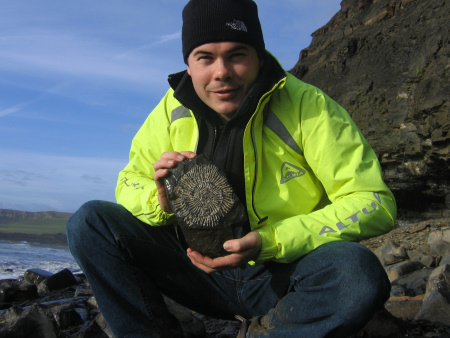
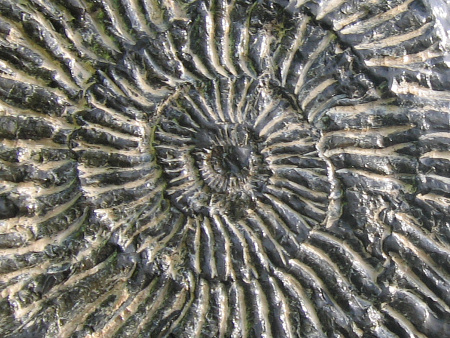
Left: Fossils such
as this Subdichotomoceras websteri ammonite can be
found loose on the foreshore having fallen from the cliff.
Right: A close-up of the Subdichotomoceras websteri ammonite shown left,
found at Hen Cliff, Lower Kimmeridge Clay Formation.
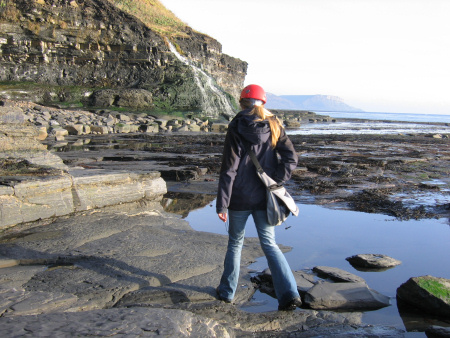
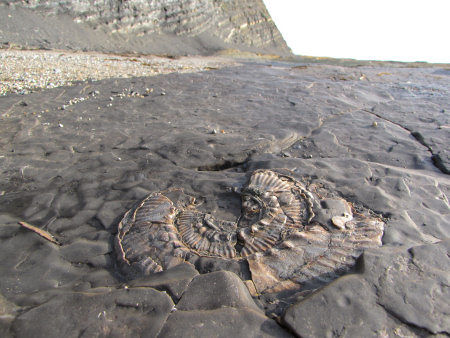
Left: Fossils can be
observed in situ on the exposed bedrock at low-tide.
Lucinda explores for fossils along the coastline southeast of
Kimmeridge Bay.
Right: An Aulacostephanus
autissiodorensis ammonite observed in situ within the
Lower Kimmeridge Clay Formation at Brandy Bay.
Please note the beach platform and cliffs are assigned SSSI status, which requires visitors avoid damaging (including hammering) the area. From a fossil hunting perspective this means it's not permitted to extract specimens that are in situ. Collecting efforts should be directed towards the loose boulders and pebbles on the foreshore. To read more about SSSI's click here.
As with all coastal locations a fossil hunting trip is best timed to coincide with a falling or low-tide. For a relatively low one-off cost we recommend the use of Neptune Tides software, which provides future tidal information around the UK. To download a free trial click here. Alternatively a free short range forecast covering the next 7 days is available on the BBC website click here.
What fossils might you find?
The fossils of the Kimmeridge Clay provide evidence of some of the organisms living in the sea during the Late Jurassic. Among the evidence of prehistoric life most frequently preserved are the shells of ammonites and occasionally the 'closing hatch', although rarely associated with the same specimen (see examples below). Other finds include the shells of bivalves, some of which occur in great numbers crushed within thin layers of sediment. Occasionally the skeletal remains of marine reptiles e.g. ichthyosaurs and plesiosaurs, and their fossilised faeces (coprolites) can also be found.
As well as the indigenous sealife, evidence of creatures that inhabited the land and sky have also been discovered by local collectors. These finds include the skeletal remains of dinosaurs and pterosaurs, the bodies of which were presumably carried by tidal currents into the area and subsequently sank to the seabed. These fossils are among the rarest of the Kimmeridge Clay and are not featured below, however their presence is noted for reference purposes.
Below are a selection of finds made over several visits to Kimmeridge Bay and the neighbouring coastal stretches, which illustrate some of the more commonly occurring fossils. Many thanks to Robert Chandler and John Callomon for providing their expertise to identify the ammonites featured.
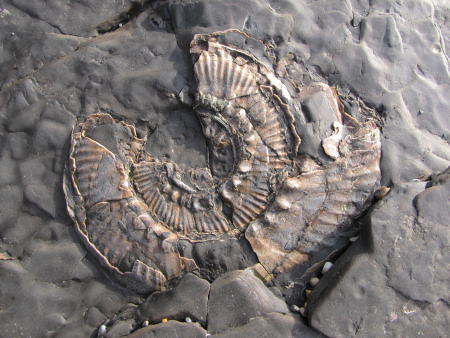
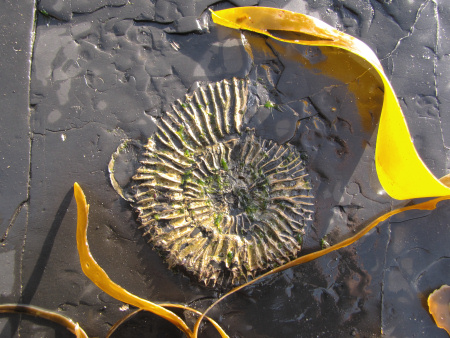
Left: An Aulacostephanus autissiodorensis ammonite observed in situ
within the Lower Kimmeridge Clay Formation at Brandy Bay.
Right: A Subdichotomoceras websteri observed in
situ within the Lower Kimmeridge Clay Formation at Brandy Bay.
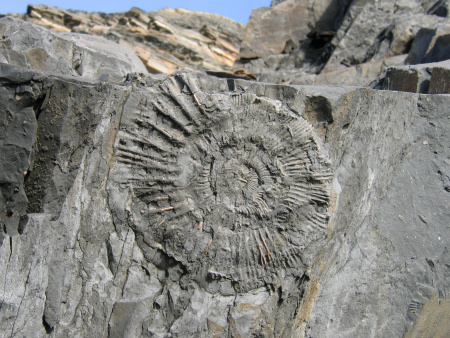
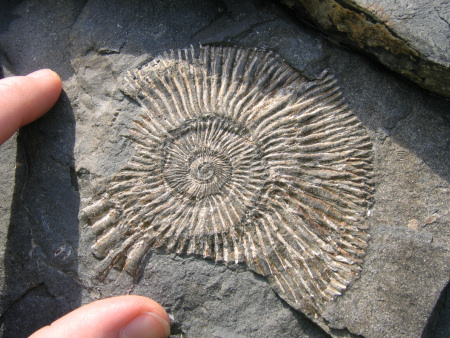
Left: A
Pectinatites ammonite viewed through the zoom-lens in
the cliff-face at Hen Cliff, southeast of Kimmeridge Bay, Upper Kimmeridge Clay Formation.
Right: A second
Pectinatites ammonite, observed in situ on the foreshore
beneath Hen Cliff, Upper Kimmeridge Clay Formation.
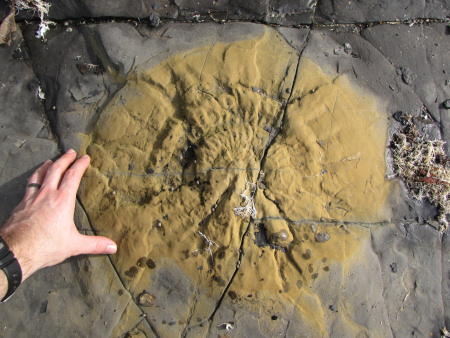
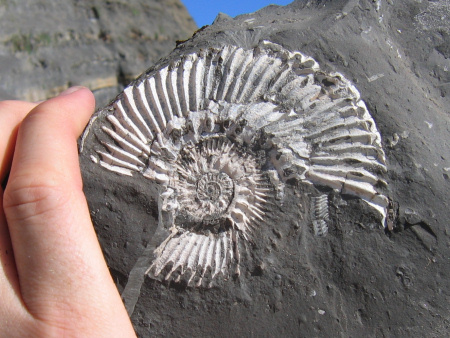
Left: A large, heavily worn Aulacostephanus ammonite observed
in situ at Hobarrow Bay, Lower Kimmeridge Clay
Formation.
Right: A Aulacostephanus eudoxus ammonite, found among loose
cliff debris at Brandy Bay, Lower Kimmeridge Clay Formation.
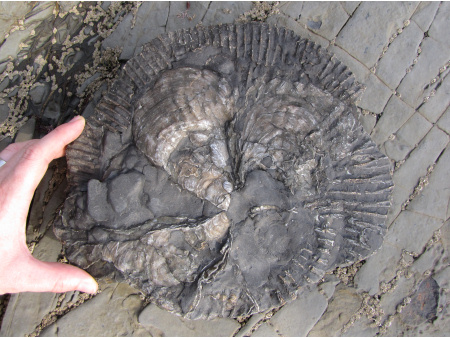
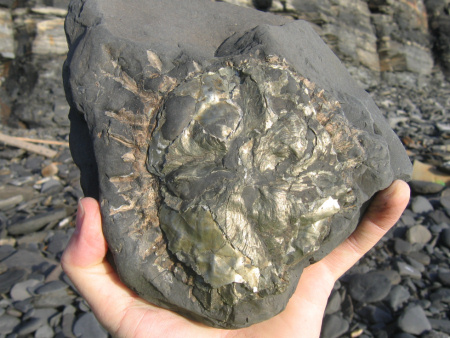
Left: A large oyster
encrusted
Pectinatites ammonite found loose at the cliff-base, Upper
Kimmeridge Clay Formation.
Right: An ammonite mostly obscured by pyritised
oyster shells, Upper Kimmeridge Clay Formation, found loose on the
foreshore.
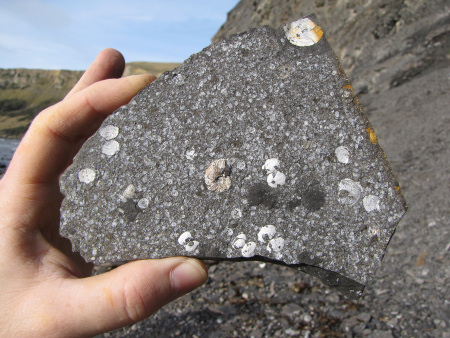
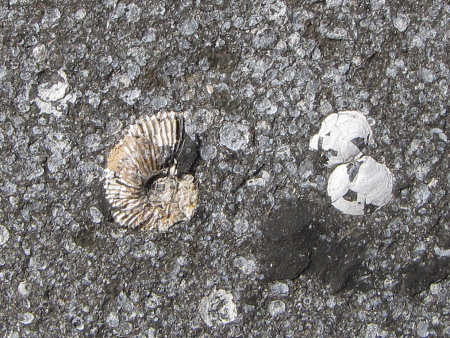
Left: A Pectinatites (Virgatosphinctoides)
ammonite among bivalves from the Upper
Kimmeridge Clay Formation at Brandy Bay.
Right: A close-up.
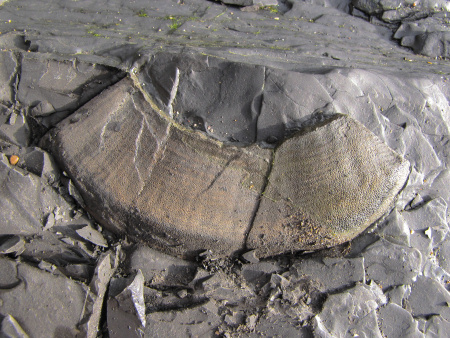
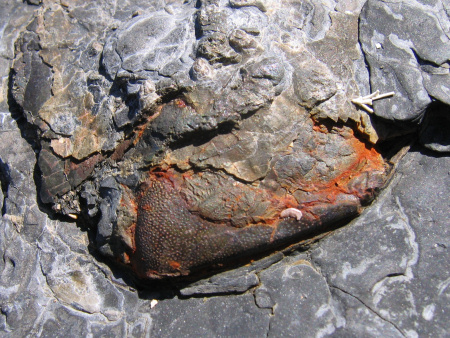
Left and right: Two
isolated anaptychus (one of a pair of plates that formed a 'closing
hatch') belonging to an Aspidoceras ammonite.
Isolated anaptychus such
as these are assigned their own
genus - in this instance Laevaptychus. Found at Brandy Bay (left)
and Hobarrow Bay (right),
Lower
Kimmeridge Clay Formation.
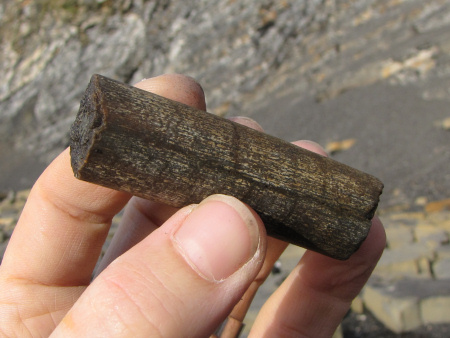
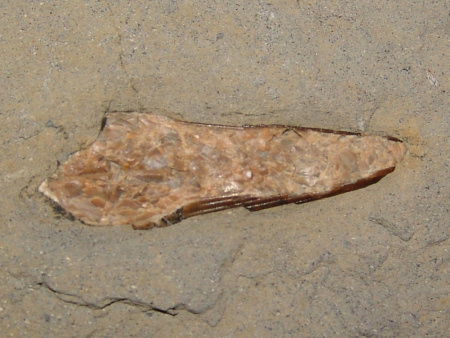
Left: A fragment of
rib belonging to a marine reptile (ichthyosaur?), found loose on the foreshore at
Brandy Bay.
Right: An ichthyosaur(?) tooth (3cm) observed in
cross-section on the surface of a fallen boulder a short distance
from Kimmeridge Bay beneath Cavell Tower.
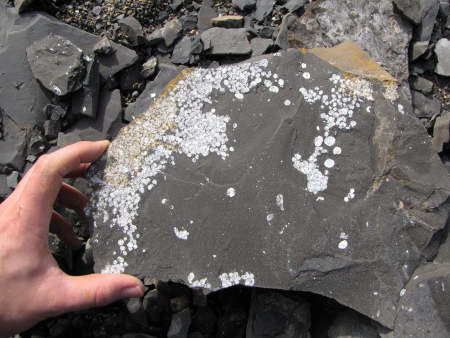
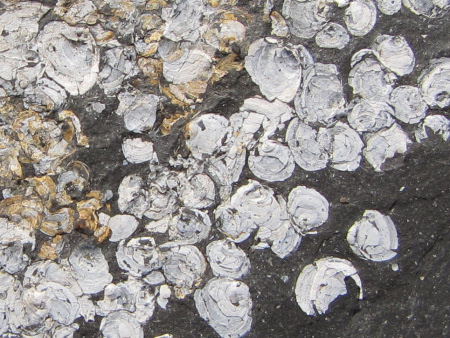
Left: A split piece
of mudstone from the Upper Kimmeridge Clay Formation at Brandy Bay,
containing a concentration of bivalve shells.
Right: A close-up.
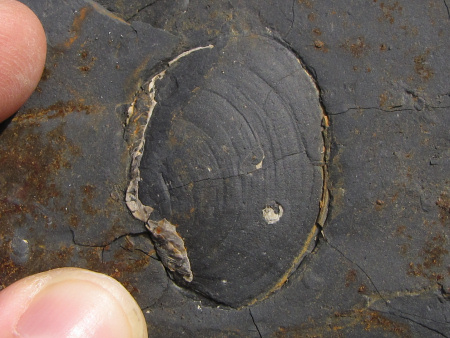
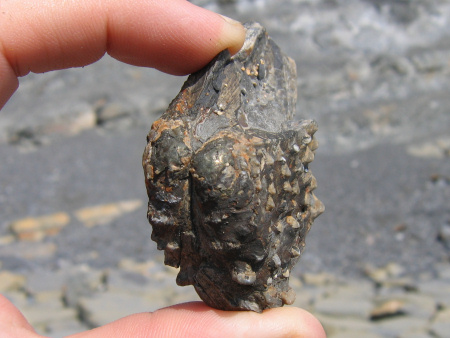
Left: The internal mould of a
bivalve shell found at Hobarrow Bay, Lower Kimmeridge Clay
Formation.
Right: A
Myophorella bivalve, found loose at the cliff base at Brandy
Bay. Upper Kimmeridge Clay Formation(?).
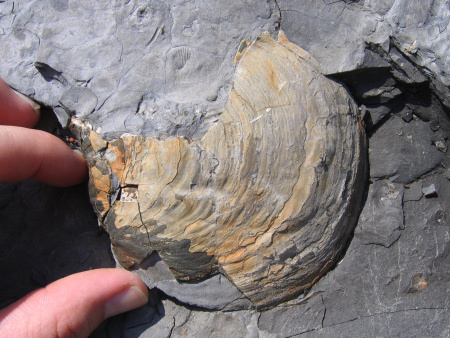
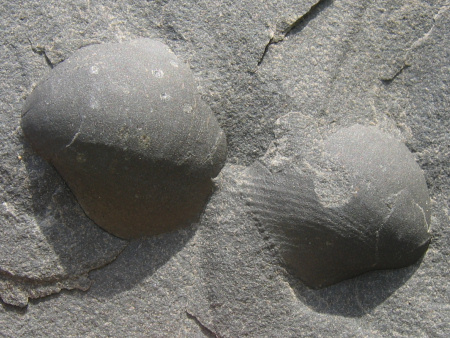
Left: A large
bivalve shell in situ at Brandy Bay, the precise horizon is
unknown.
Right: The internal moulds of a pair or brachiopod
valves, found on the surface of a fallen boulder beneath Hen Cliff, Upper
Kimmeridge Clay Formation.
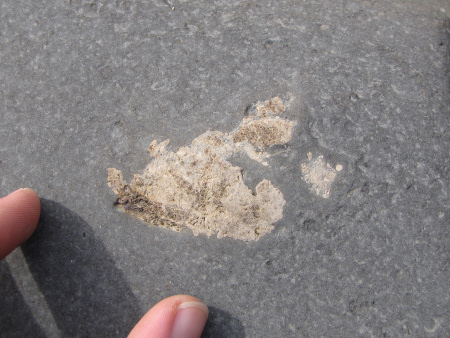
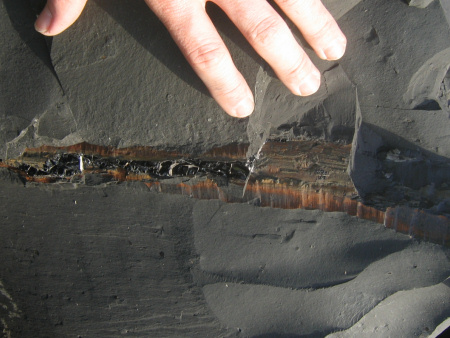
Left: A coprolite
(fossilised faeces) of a marine reptile or large fish, exposed on
the surface of a sea weathered boulder at Brandy Bay.
Right: A fragment of carbonised drift wood on the surface
of a fallen boulder beneath Hen Cliff, presumably Upper Kimmeridge Clay Formation.
Tools & equipment
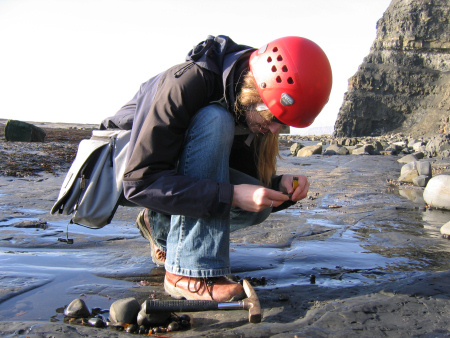
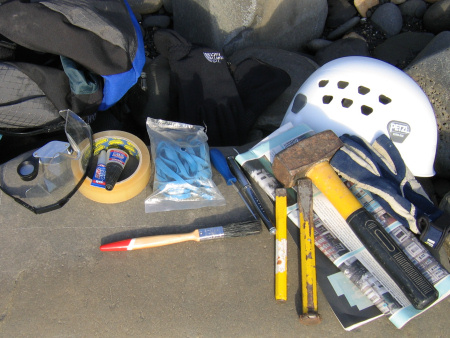
Left: Lucinda searching for fossils near Kimmeridge Bay.
Right: A selection of useful tools and equipment for fossil hunting in the Kimmeridge area.
It's a good idea to spend some time considering the tools and equipment you're likely to require while fossil hunting in the Kimmeridge area. Preparation in advance will help ensure your visit is productive and safe. Below are some of the items you should consider carrying with you. You can purchase a selection of geological tools and equipment online from UKGE.
Hammer: A strong hammer will be required to split prospective rocks. The hammer should be as heavy as can be easily managed without causing strain to the user. For individuals with less physical strength and children (in particular) we recommend a head weight no more than 500g. Please note that the use of hammers within Kimmeridge Bay itself is not permitted.
Chisel: A chisel is required in conjunction with a hammer for removing fossils from the rock. In most instances a large chisel should be used for completing the bulk of the work, while a smaller, more precise chisel should be used for finer work. A chisel founded from cold steel is recommended as this metal is especially engineered for hard materials.
Safety glasses: While hammering rocks there's a risk of injury from rock splinters unless the necessary eye protection is worn. Safety glasses ensure any splinters are deflected away from the eyes. Eye protection should also be worn by spectators as splinters can travel several metres from their origin.
Strong bag: When considering the type of bag to use it's worth setting aside one that will only be used for fossil hunting, rocks are usually dusty or muddy and will make a mess of anything they come in contact with. The bag will also need to carry a range of accessories which need to be easily accessible. Among the features recommended include: brightly coloured, a strong holder construction, back support, strong straps, plenty of easily accessible pockets and a rain cover.
Walking boots: A good pair of walking boots will protect you from ankle sprains, provide more grip on slippery surfaces and keep you dry in wet conditions. During your fossil hunt you're likely to encounter a variety of terrains so footwear needs to be designed for a range of conditions.
For more information and examples of tools and equipment recommended for fossil hunting click here or shop online at UKGE.


ADVERTISEMENT BY UKGE - OFFICIAL ADVERTISING PARTNER OF DISCOVERING
FOSSILS
Protecting your finds
It's important to spend some time considering the best way to protect your finds onsite, in transit, on display and in storage. Prior to your visit, consider the equipment and accessories you're likely to need, as these will differ depending on the type of rock, terrain and prevailing weather conditions.
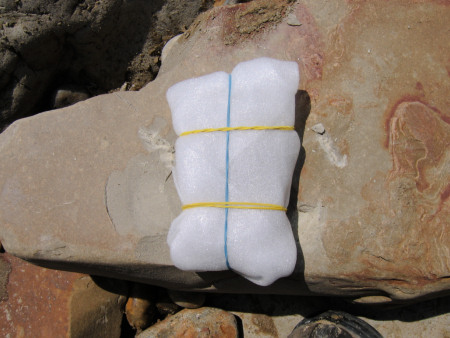
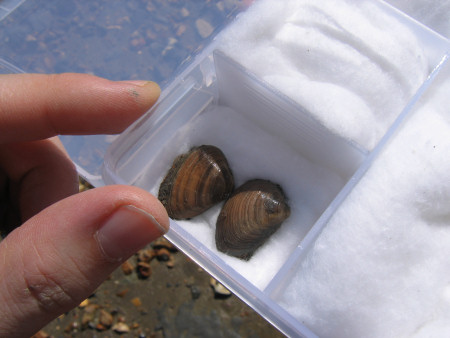
Left: Fossil
wrapped in foam, ready for transport. Right:
A small compartment box containing cotton wool is ideal for
separating delicate specimens.
When you discover a fossil, examine the surrounding matrix (rock) and consider how best to remove the specimen without breaking it; patience and consideration are key. The aim of extraction is to remove the specimen with some of the matrix attached, as this will provide added protection during transit and future handling; sometimes breaks are unavoidable, but with care you should be able to extract most specimens intact. In the event of breakage, carefully gather all the pieces together, as in most cases repairs can be made at a later time.
For more information about collecting fossils please refer to the following online guides: Fossil Hunting and Conserving Prehistoric Evidence.
Join us on a fossil hunt
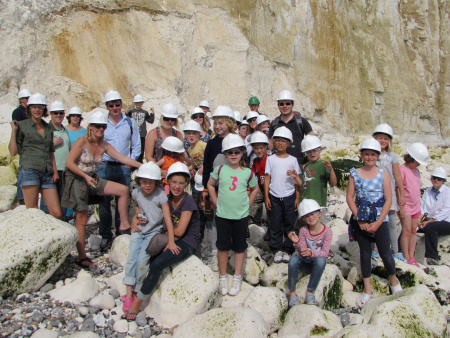
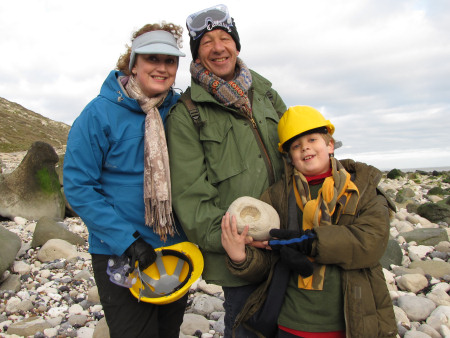
Left: A birthday party with
a twist - fossil hunting at
Peacehaven.
Right: A family hold their prized ammonite at Beachy Head.
Discovering Fossils guided fossil hunts reveal evidence of life that existed millions of years ago. Whether it's your first time fossil hunting or you're looking to expand your subject knowledge, our fossil hunts provide an enjoyable and educational experience for all. To find out more CLICK HERE

